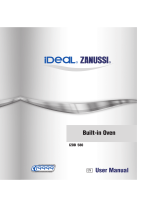
As the fan oven quickly reaches tempera-
ture, it is not usually necessary to preheat
the oven although you may find that you
need to allow an extra 5-7 minutes on
cooking times. For recipes which require
higher temperatures, best results are ach-
ieved if the oven is preheated first, e.g.
bread, pastries, scones, souffles, etc.
–
Lower temperatures
Fan-assisted cooking generally requires
lower temperatures than conventional
cooking.
Follow the temperatures recommended in
the cooking chart. Remember to reduce
temperatures for top and bottom heat by
about 20-25 ºC for your own conventional
recipes.
–
Even heating for baking
The fan oven has uniform heating on all
shelf positions. This means that batches of
the same food can be cooked in the oven
at the same time. However, the top shelf
may brown slightly quicker than the lower
one.
This is absolutely normal. There is no fla-
vour transference between dishes.
Top and bottom heating element
– The middle shelf position allows for the
best heat distribution. If you want a base
browning, simply place the cakes and pas-
tries on to a lower shelf position in the
oven. To increase top browning, raise the
shelf position.
– The material and finish of the baking trays
and dishes used will affect base browning.
Enamelware, dark, heavy or nonstick uten-
sils increase base browning, while oven
glassware, shiny aluminium or polished
steel trays reflect the heat away and give
less base browning.
– Always place dishes centrally on the shelf
to ensure even browning.
– Stand dishes on suitably sized baking
trays to prevent spillage onto the base of
the oven and make cleaning easier.
–
Do not place dishes, tins or baking
trays directly on the oven base as it be-
comes very hot and damage will occur.
When using this setting, heat comes from
both the top and bottom elements. This
allows you to cook on a single level. This is
particularly suitable for dishes which re-
quire extra base browning such as, e. g.
quiches and flans.
Gratins, lasagne and hotpots which require
extra top browning also cook well in the con-
ventional oven.
How to use heat from above and below:
1. Turn the oven controller to the function
you want
2. Turn the temperature control to the tem-
perature you want.
Bottom oven element
This function is particularly useful when bak-
ing cakes and pastry bases as well as finish-
ing off quiches or flans, to ensure that the
quiche or pastry base is cooked through.
The temperature controller’s lamp lights
up until the correct temperature is
reached. It then cycles on and off to in-
dicate that the temperature is being
maintained.
Grilling
– Most foods should be placed on the grid
in the grill pan to allow maximum circula-
tion of air and to lift the food out of the fats
or juices. If preferred, foods such as, e. g.
fish, liver and kidneys may be placed di-
rectly on the grill pan.
– Food should be thoroughly dried before
grilling to minimise splashing. Brush lean
meats and fish lightly with a little oil or mel-
ted butter to keep them moist during cook-
ing.
– Accompaniments such, e. g. tomatoes
and mushrooms may be placed under-
neath the grid when grilling meats.
– When toasting bread, we suggest that the
top runner position is used.
– The food should be turned over during
cooking, as required.
Using the grill
The grill causes direct heat to gather quickly
in the middle of the grill pan. For best results,
grill food in small quantities. Energy can also
be saved in this way.
1. Turn the oven control in order to turn on
the oven
2. Turn the temperature control to the tem-
perature you want.
3. Choose the suitable shelf for the grill pan
and grill according to whether or not the
progress 7



















